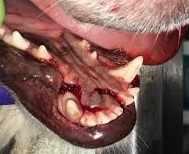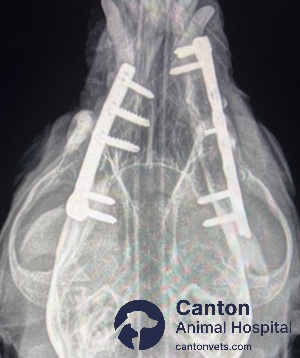Home | Surgeries | Jaw Fractures Repair in Dogs and Cats
Jaw Fractures Repair in Dogs and Cats
Mandibular Fractures in Dogs and Cats
At Canton Animal Hospital, we provide expert diagnosis and surgical care for mandibular fractures in dogs and cats—a painful condition that disrupts your pet's ability to eat, vocalize, and lead a comfortable life. The mandible (lower jaw) plays a vital role in biting, chewing, and oral alignment. A fracture to this bone must be treated promptly to avoid long-term complications such as malocclusion, infection, or chronic pain.
Our experienced team uses advanced imaging and precision surgical techniques—including interdental wiring and bone plating—to restore function and comfort. Whether your pet’s injury is the result of trauma or an underlying condition, we’re here to help them recover with compassionate and comprehensive care.
Causes of Mandibular Fractures
Mandibular fractures in pets can occur due to sudden trauma or underlying disease that weakens the jaw bone. Understanding the root cause helps determine the most appropriate treatment approach.
Vehicular trauma: One of the most common causes in dogs and cats hit by cars or bicycles.
Falls from height: Frequently seen in indoor cats falling from elevated surfaces.
Bite wounds or rough play: Fractures may result from altercations between pets or during play, especially in small breeds.
Chewing hard objects: Items such as bones, antlers, or metal can place excessive force on the jaw and cause fractures.
Pathologic fractures: These occur when the jawbone is weakened due to:
Severe periodontal (gum) disease
Bone infections (osteomyelitis)
Bone tumors or oral cancer
Metabolic diseases (e.g., kidney disease, hyperparathyroidism)
Malnutrition or endocrine disorders
Featured resources

We Welcome New Patients!
We're always happy to give your furry friend care at our hospital. Get in touch today!
Contact Us
Signs Your Dog or Cat May Have a Mandibular Fracture
Recognizing the signs of a mandibular fracture can lead to earlier diagnosis and better outcomes. Symptoms may vary based on the severity and location of the fracture.
Excessive drooling or inability to close the mouth
Bleeding from the gums or oral cavity
Difficulty eating, chewing, or reluctance to open the mouth
Visible facial swelling or jaw asymmetry
Pain when touched near the jaw or pawing at the mouth
Misaligned, loose, or broken teeth
Cats may show more subtle signs, such as hiding, decreased appetite, or quiet behavior. If your pet shows any of these symptoms, prompt evaluation is recommended.
Fracture Types & Locations
Different types and locations of fractures influence the surgical plan and prognosis:
Symphyseal fractures: Occur at the midline where the two jaw halves meet—often seen in younger or small breed dogs.
TMJ luxation: Dislocation of the temporomandibular joint without an actual bone break.
Simple fractures: Clean, single breaks that are typically easier to stabilize.
Comminuted fractures: Involve multiple bone fragments; require more complex repair.
Open vs. Closed fractures: Open fractures communicate with the oral cavity or environment; closed fractures do not.
Understanding the fracture pattern helps guide us toward the most appropriate repair strategy.

Diagnostic Approach to Mandibular Fractures in Dogs and Cats
We use a multi-modal diagnostic strategy to ensure accurate assessment and surgical planning:
Physical and oral exam: Performed under sedation or anesthesia to identify fractures, assess pain, and examine teeth, gums, and soft tissues.
Radiographs (X-rays): Capture detailed images of the jawbone and teeth to locate fractures and evaluate severity.
CT imaging (if needed): Offers 3D visualization for complex, comminuted, or hard-to-reach fractures.
Thoracic radiographs: Rule out internal injuries such as pulmonary contusions or pneumothorax from trauma.
Orthopedic and neurologic screening: Detect concurrent injuries or neurological deficits, especially in cases of head trauma.
Lab work and disease screening: In suspected pathologic fractures, we assess for underlying conditions that may impair bone strength or healing.

Treatment Options
Each technique is selected based on fracture type, location, and your pet’s overall health. We offer a range of surgical options tailored to your pet’s condition, comfort, and age:
Muzzle stabilization: Non-invasive option for minor, non-displaced fractures. A soft muzzle keeps the jaw aligned during healing.
Interdental wiring & acrylic splints: Thin wires are anchored around teeth to stabilize the fracture. Often paired with splints for extra support. Effective for rostral (front-of-jaw) injuries.
Bone plating: Small titanium or stainless-steel plates are surgically attached to the bone with screws to secure unstable or high-stress fractures.
External fixation: Uses external pins and connecting bars to stabilize the fracture externally ideal for open, infected, or complex fractures.
Dental procedures: Extractions may be required for teeth affected by the fracture or severe dental disease.
Risks and Complications
While complication rates are low, it's important to be aware of potential risks:
Anesthetic risks, especially in geriatric or compromised pets
Infection at surgical sites or external pin tracts
Delayed healing or non-union of fracture sites
Malocclusion (misaligned bite) leading to eating difficulty
Osteomyelitis (bone infection) requiring further treatment
Nerve damage causing temporary or permanent numbness
Prompt treatment and ongoing monitoring help minimize these risks.
Expected Outcome and Prognosis
With early intervention and appropriate surgical repair, most dogs and cats recover fully from mandibular fractures.
Excellent prognosis in young, otherwise healthy pets with clean or simple fractures
Variable outcomes in complex or pathologic fractures, especially if underlying disease is present
Timely follow-up care and adherence to at-home restrictions are vital to avoid complications
Most pets regain full jaw function and return to normal eating habits within weeks
Post-Surgical Care & Recovery
Home Care Checklist
Feed soft or pureed food for 4–6 weeks
No chew toys, bones, or dry kibble
Confine to a crate or small room to limit activity
Clean pin tracts daily (if present) using warm water
Monitor incision for swelling, discharge, or redness
Administer medications exactly as prescribed
Watch for appetite changes or signs of discomfort
Follow-Up Timeline
4–6-week follow-up to evaluate healing with X-rays
Removal of wiring or external devices (if applicable)
Gradual return to normal activity and regular feeding
Owner diligence is essential—healing time and outcome depend on proper home care and compliance.
Frequently Asked Questions (FAQs)
We understand that learning your pet has a jaw fracture can be overwhelming. Below are answers to some of the most common questions pet owners have about mandibular fractures, surgical care, and recovery for both dogs and cats.
Featured resources

We Welcome New Patients!
We're always happy to give your furry friend care at our hospital. Get in touch today!
Contact Us